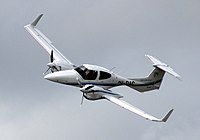
Photo from wikipedia
This paper presents a digital twin-driven fault diagnosis approach based on a graphical model and an adaptive extended Kalman filter algorithm for autonomous surface vehicles. In contrast with the traditional… Click to show full abstract
This paper presents a digital twin-driven fault diagnosis approach based on a graphical model and an adaptive extended Kalman filter algorithm for autonomous surface vehicles. In contrast with the traditional adaptive Kalman filter algorithm, where the fault parameters are treated as extended state variables, the newly proposed adaptive extended Kalman filter algorithm estimates the magnitude of the faults by calculating the parameter estimation gains directly from the sensor systems. To this end, the algorithm utilizes data from a global navigation satellite system receiver assuming the persistence of excitation conditions on the control inputs. The algorithm is tested in the Otter, an autonomous surface vehicle developed by Maritime Robotics, in which one of its propellers is faulty. Technically, the digital twin receives real-time data from the sensor system, estimates the magnitude of the actuator faults, and visualizes the results in a web-based application using JavaScript with Three.js library and Mapbox for real-world 3D map generation. Information regarding the magnitude of the faults is important for fault-tolerant control. Simulation and experimental results show the proposed approach is able to detect and estimate the actuator faults accurately.
Journal Title: IEEE Access
Year Published: 2023
Link to full text (if available)
Share on Social Media: Sign Up to like & get
recommendations!